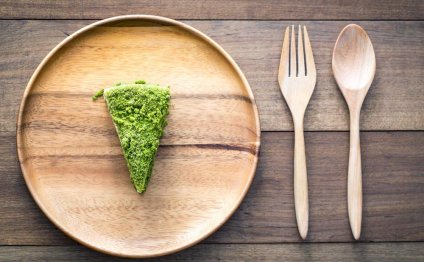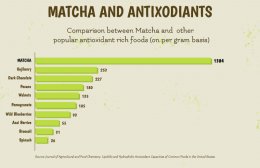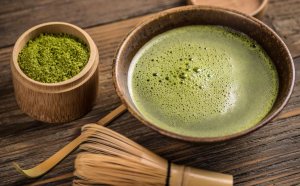
Matcha tea Recipes
Matcha is a 100% whole-leaf green tea from Japan, meticulously grown, gently dried and stone-ground into a bright green, unfermented powder. Because the entire unfermented leaf is ground and combined with hot water, consuming Matcha provides ALL the vitamins, minerals, antioxidants, and amino acids inherent in the plant itself, while delivering a richly organic, full-bodied and deeply satisfying flavor profile not found in steeped teas.
How does Matcha Green Tea Benefits Compare to Other Teas?
Matcha is unrivaled among green, black and other teas. Brewed teas deliver only a fraction of Matcha’s nutritional benefits because the leaves are disposed of as part of the preparation process. Matcha does not undergo the same level of fermentation (enzymatic oxidation) as other teas, which helps maximize its potency. As a result, it takes about 10 cups of regular green tea to equal just 1 cup of Matcha’s nutrient and antioxidant value, yet Matcha has similar caffeine content.
Why is Matcha better than the average, everyday cup of Joe?
You know the feeling, sluggish and unfocused, needing some pep in your step, time to reach for that cup of Joe… But what if there was a nutrient and life-giving alternative that didn’t leave you with the jitters, brown teeth and bad breath? Instead of a dark, dreadful cup of joe, you can enjoy a bright green cup of amazing nutrients. Matcha Tea can give you extra focus and energy to get you through your day, and also enrich your life with vitamins, minerals, antioxidants and amino acids. Matcha Tea does have caffeine in it; 1 gram (about a half teaspoon) has about 35 mg of caffeine vs. 80-120 mg typically found in 1 teaspoon of coffee. Unlike coffee, the phytonutrients and amino acids in Matcha Tea allows the human body to use caffeine in a much more beneficial way opposed to caffeine from coffee. The caffeine in Matcha bonds with “the champions of antioxidants” known as catechins, and enters into the blood stream slowly. The richness of fiber in Matcha Tea also helps to stabilize already healthy blood sugar levels.
Why Is Matcha Powdered Tea More Expensive Than Green Tea?
In short, Matcha is a premium tea due to the high degree of hand processing, low plant yield, and the relatively limited regional and seasonal production concentrated in Japan. The finest teas are generally regarded as the greenest in color, which requires special care and control of the growing environment. Matcha is the highest-grade of tea in the world- one look and you will be taken aback by its vibrant green hue. The finest Matcha Tea is also exclusive to Japan- it is much more limited in supply than regular green tea, due to the meticulous growing, drying and powdering steps and the regional soils and climate that make it thrive and fully develop. It is the perfectly hand-cut “flawless diamond” among teas in the world. Matcha Tea Leaves are lovingly picked by experienced hands, selecting only new top leaves and shoots. The plants are also specially shaded during the end of the growing cycle to boost chlorophyll content and antioxidant potency. Matcha Tea is 100% stone-ground via a slow and careful process to obtain an extremely fine, uniform powder that dissolves and froths in water. Only about 40 grams of powdered Matcha can be produced per hour through the stone-grinding process. BõKU® Super Match Green Tea is a proprietary custom blend of the most functionally potent Matchas, together with the finest tasting, smoothest ceremonial Matcha. We’ve designed this blend to combine the most functional, nutrient-dense benefits with the most regal and richly flavored character of traditional Matcha- the only blend of its kind, to ensure whole-body utilization and satisfaction.
What Is The Unique History of Matcha Tea and it’s Amino Acids?
Matcha Tea has an impressive history that goes back over a thousand years. Japanese monks who considered meditation important also realize the benefit of staying alert. They learned that Matcha Tea allowed them to be focused without being “wired.” In today’s coffee-crazed culture, this may seem like a dichotomy but, science has proven what these ancient monks experienced. A unique Amino Acid called L-Theanine has been proven to promote relaxation while keeping brain function stimulated. This amino acid is also believed to help memory and learning. The great news is that Matcha Tea has up to 5 times more L-Theanine Amino Acid than common black and green teas. This helps buffer the caffeine content and deliver amazing concentration and focus without the jitters of other caffeinated beverages.
What does Matcha green tea taste like?
Match Tea is the taste of health and freshness. It is rich and creamy compared to more astringent green and especially black fermented teas. The whole leaf organic content helps buffer any bitter or harsh flavor, and the powdered consistency makes it light yet full on the palette.
How Do I Prepare The Perfect Cup of Matcha Green Tea?
Matcha Tea is unique in that it is a fine green powder. Traditional Matcha is prepared by placing a portion of the tea in a bowl or cup, and then adding hot water. The tea is then dissolved and aerated by using a traditional bamboo whisk (or Chasen in Japanese) until creamy and frothy.
Is BõKU® Super Matcha Green Tea a “Super Food?”
Super Food and beyond! Matcha has one of the highest ORAC (Oxygen Radical Absorbance Capacity) values of any plant know to man! Further, the high content of fiber, amino acids, vitamins, minerals and related cofactors that support nutrient bioavailability are uniquely delivered via use of the whole leaf, making Matcha an amazingly potent food source that naturally promotes health. Matcha requires only picking, natural drying, and stone grinding, so its lack of industrial processing or modification truly makes it a natural Super Food.
How does Matcha support detoxification of the body?
Matcha-style detoxification is literally ‘made in the shade’- Matcha Green Tea is carefully grown in shaded plots toward the end of the growing cycle. To compensate for the sparse light conditions, the plant produces a high chlorophyll content to support photosynthesis. Because only the most pristine, youthful leaves are picked and ground whole into a fine powder, all of the chlorophyll is delivered to the body as an amazing and potent detoxifier. Vibrantly green, powdered Matcha helps to rid the body of toxic chemical and heavy metal buildup. Chlorophyll has also been reported to have an antioxidant and antibacterial effect, as well as an alkalinizing effect. If it’s cleansing you want, green is the color of vibrant health!
Can I use Matcha Green Tea To Assist In My Weight-loss Goals?
Matcha is a healthy, natural, and nutrient-dense drink that is almost calorie free. Even better news is the fact that Matcha has been reported to help boost metabolism and thus help to burn fat. Research shows that this is accomplished in part through Matcha green tea’s ability to improve physical endurance by nearly 25%, creating additional calorie burning- a sure fire way to accelerate and compliment your weight-loss goals!
What is So Special About Matcha Green Tea’s Antioxidant Levels?
Both green and black teas are widely recognized and proven to have extraordinary antioxidant levels – Matcha 100% whole-leaf powdered green tea takes this to another level altogether. Incorporation of the entire leaf delivers chlorophyll, co-factors and other organic buffers that help improve the bioavailability of Matcha’s potent antioxidants. Plus, Matcha’s uniquely elevated level of “catechins” (EGCg), give it a distinct advantage over regular green and black teas. These factors mean Matcha is truly special in its ability to deliver an abundance of antioxidants, which we have all seen cited in many studies as nature’s way of helping support the immune system. You may have heard that pomegranate & blueberries are packed with antioxidant content, yet Matcha Green Tea has been reported to have much higher antioxidant levels than these amazing fruits. Dark chocolate, regarded as having an even higher free radical suppressing ability (ORAC*, or Oxygen Radical Absorbance Capacity) than pomegranate & blueberries, still pales in comparison; Matcha is still about 7 times higher in antioxidants!  * Tuft’s University gave Matcha Green Tea an ORAC rating of 1, 300 units per grams vs. 105 units per gram for pomegranate and 91 units per grams for blueberries.
* Tuft’s University gave Matcha Green Tea an ORAC rating of 1, 300 units per grams vs. 105 units per gram for pomegranate and 91 units per grams for blueberries.
What Are The “Polyphenols” That Are Found In Matcha Tea?
These are simply the powerful antioxidants described above that make up about 30% of the Matcha Green Tea’s dry leaf weight. Because Matcha is unfermented, the polyphenols exist primarily as catechins. The most powerful catechins (antioxidants) are known as ECGg. What this means in layman’s terms is this: 1 cup of Match Green Tea has a much greater antioxidant affect that a serving of broccoli, spinach, Kale, carrots, or strawberries, as well as other green and black tea’s per above.
blog before we die zibra blog before and after blog behind the scenes blog behind the black food blog behind the scenes left behind blog story behind blog meaning behind blog blog between between blog and microblog blog difference between vlog difference between blog and website difference between blog and article similarities between blog and hyper poetry difference between blog and forum blog beyond the obvious beyond blog beyond's blog homepage d&d beyond blog go beyond blog brexit & beyond blog travel beyond blog coachmen beyond blog blog but first coffee blog but blog but.fr wordpress not blog but website best buy blog nak buat blog cara buat blog blog gardien de but blog by gabby petito blog by jackie bavaro blog by google blog by ai weiwei blog by marvin williams blog by number blog by high school students blog by sophia lee blog contra ponto blog contra corrente blog contra impugnantes blog contra bolsonaro blog contra las cuerdas blog contra incendios blog contra el amor blog contra e verso blog during pandemic blog during spanish period blog during lockdown blog during american period blog during quarantine travel blog during covid blog ideas during covid blog topics during coronavirus blog even blog even 3 blog not even wrong blog break evenShare this Post
Related posts
Matcha green tea Recipes
I cannot stand when someone adds sweet to Green tea. I have spent three years and Japan loving the fact I could drink real…
Read MoreMatcha tea whisk
Enjoying a bowl of matcha tea in the kitchen is a nice way to blend some of the formal elements of tea ceremony with the…
Read More










